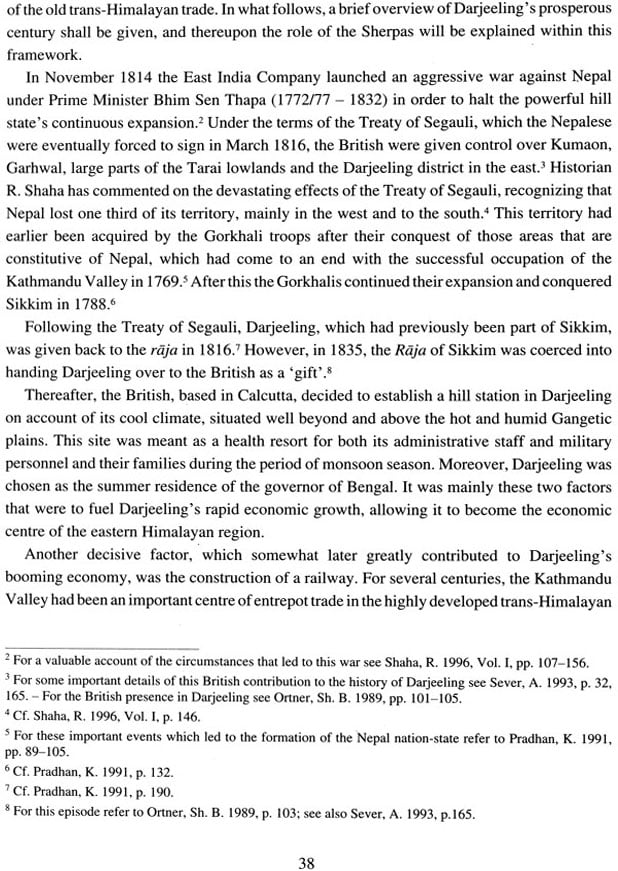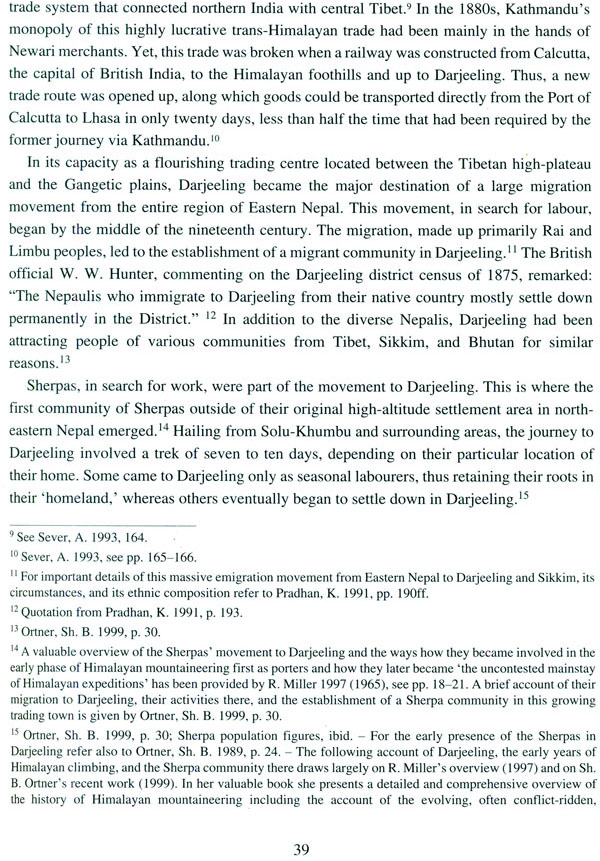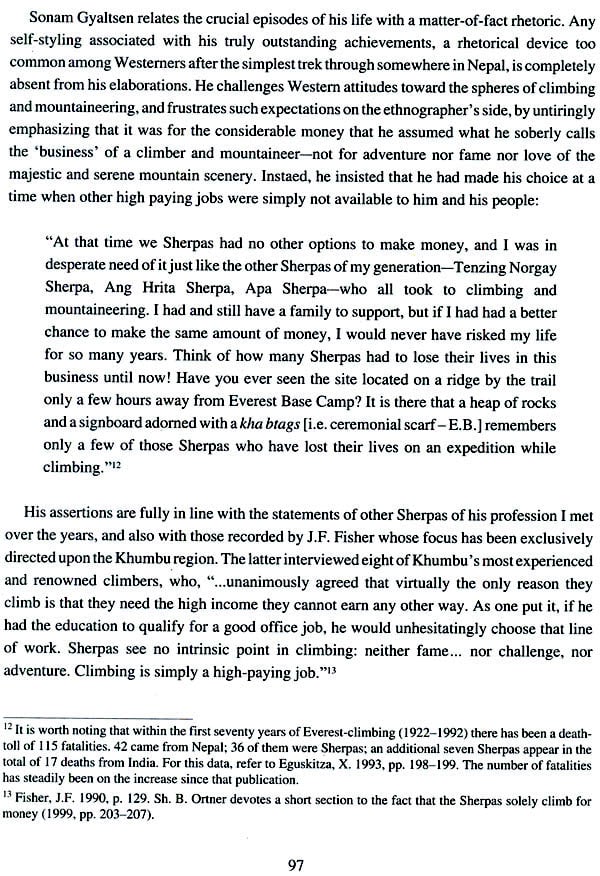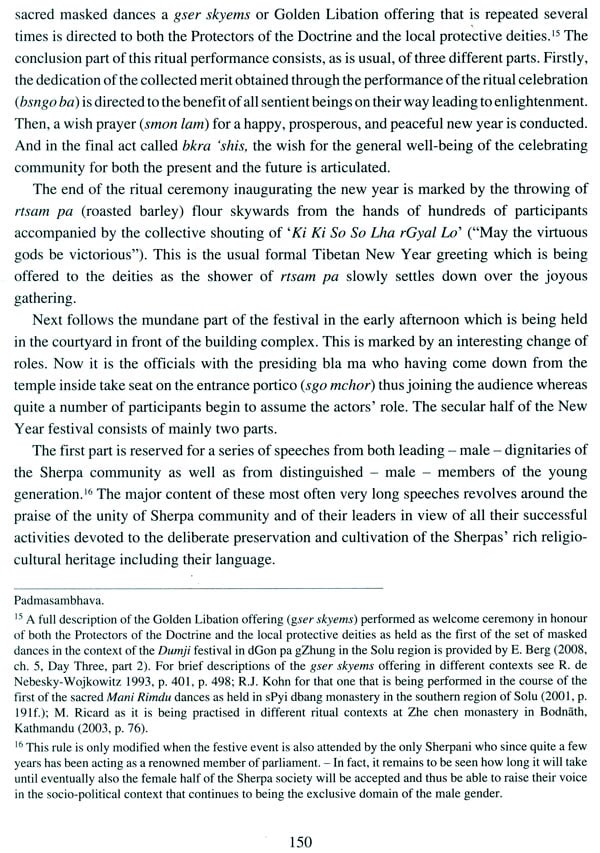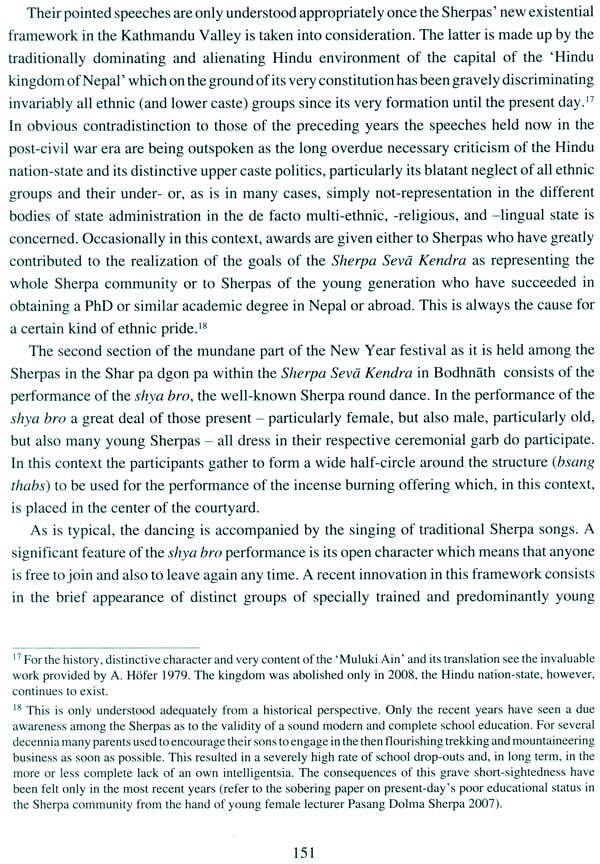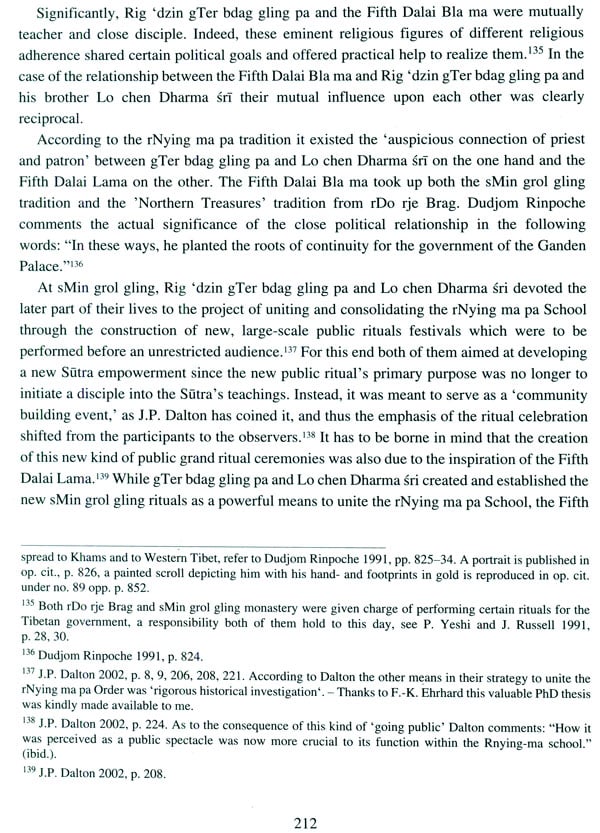
Building The Sherpas' New Present in the Age of Globalisation
Book Specification
| Item Code: | NAO813 |
| Author: | Eberhard Berg |
| Publisher: | Lumbini International Research Institute, Nepal |
| Language: | English |
| Edition: | 2011 |
| ISBN: | 9789937553018 |
| Pages: | 288 (19 Color Illustrations) |
| Cover: | Paperback |
| Other Details | 11.0 inch X 8.5 inch |
| Weight | 760 gm |
Book Description
“Religion [i.e the Dharma –E.B.] is the most powerful agency of social service and all the activities of the people are guided by the idea of the religion.”
Ang Dorje Lama(1940-1992)
A leading Sherpa ‘big man’, Ang Dorje lama was the spokesman of the group of three influential Sherpas who were deeply commited to the urgent tasks of the revial of the sharpas’ religious and cultural traditions. These three personages represent the major driving force that was to set into motion the remarkable process of revitalisation under the guidance of the clerics, which can be witnessed today. Their main effort was to lead the construction of the Sherpa Seva Kendra, the Sherpa Community Center in Bodinath,KTM. This community institution is the arena in which the novel tradition is being created, strengthened and reaffimed.
Ang Dorje Lama, along with his wife and several relatives, lost his life in the tragic Thai Air Crash at Gosainkund in the year 1992. “We are a people in the midst of change, and what will happen in the future is hard to say. But so far, though together, and there has not been much intermarriage with outsiders.”
Tenzing Norgay(1914 or 1915-1986)
Tensing Norgay, along with the late the Edumund Hillary, reached the summit of Mt. Everest on 29 May 1953. His far- sighted observation was mentioned in his first autobiography (1955,p. 108).
“It is important to remember, however, that Tibetian Buddhism especially the form followed by the Ryning ma pa, is intended for the multiplicity of metaphors and tutelary deities lies in the fact that there must be a practice suited to every sentient creature somewhere. Forms or metaphors that were relevant yesterday may lose their efficacy in the changed situation of today.”
| Acknowledgement | 5 | |
| List of Illustrations | 9 | |
| Breif chronology of Sherpa history | 15 | |
| Introduction | The state of Sherpa religion, culture and society at the end of the millennium, its history, and the current effort at a comprehensive revitalisation of the Sherpas' cultural history | 21 |
| 1. A vignate | 21 | |
| 2. The setting of the investigation | 25 | |
| 3. The book's subject, its specific focus, and the related goals | 30 | |
| Chapter One | Two consecutive waves of out-migartion from the Sherpas' homeland and the profound changes brought about by their successful involment in the trekking and moutainineering industry | |
| 1. Migration to Darjeeling from the mid-nineteentth centutry onwards and the begining of the Sherpas' involment in the early period of Himalayan climbing and moutaineering | 37 | |
| 2. Migartion from both Solu-Khumbu and Darjeeling from the mid-twentieth centrury onwards to the Kathmandu in the early preferably to Bodinath:emergence of the Sherpa Valley community, construction of the Sherpa Seva Kendra, the Sherpa Community Center in Bodhnath | 42 | |
| 3. On the profound changes brought about by the Sherpas' successful involvement in the trekking and mountaineering industry: ruputre of tradition , loss of cultural heritage, culrural alienation, and the currently growing awaremess us to the urgent need of the both a compreshensive revitalisation of Sherpa Buddhism and culture and modern education | 47 | |
| Chapter Two | The activities and goals associated with the establishment of the Sherpa Seva Kendra or Sherpa Service Center | 57 |
| 1. A new all- embracing Sherpa community with a corresponding novel sense of unity and identity in the making | 57 | |
| 2. The particular circumstances that had ultimately led to the construction of the Sherpa Seva Kendra | 65 | |
| Chapter Three | The mortuary rites as performed among the Sherpas in the context of the Tibetan cultural world; it was the impossiblity of their proper performance that was the ultimate driving.force behind the building of the Sherpa Seva Kendra | 68 |
| Chapter Four | On the foundation of the Sherpa Seva Kendra and the Different steps of its subsequent expansion | 87 |
| Chapter Five | Pars pro toto: the life history of a leading Sherpa 'big man' embodying the major aspects of what ultimately was to lead to the foundation of the Sherpa Seva Kendra and the associated strong move aiming at a thorough revitalisation of Sherpa Buddhism and culture: | 91 |
| 1. The life history of Sonam Gyaltsen Sherpa, the main informant of this investigation | 91 | |
| 2. Sonam Gyaltsen Sherpa's life Traditional cultural heritage urgently needs the deliberate revitalisation | 99 | |
| Chapter Six | The Sherpa Seva Kendra Building ensemble: detailed description of both the scared and the mundane place and space and the distinctive socio-cultural features of the novel 'temple and community center' (mi dzom sa) of the entire Sherpas community | 102 |
| Chapter Seven | The tradition of Tibetan Buddhist sacred architecture and the novel architectural design of the Sherpa Seva Kendra Building ensemble, the example of a new kind of Tibetan Buddhist religious edifice | 115 |
| Chapter Eight | Ownership, administeration income and ceratain services provided by the Sherpa Seva Kendra for the Members of the Sherpa community | 124 |
| Chapter Nine | Description of the economics of ritual celeberation as established in the Sherpas Seva Kendra: the contribution of two traditional modes of festival patronage in the new setting | 129 |
| 1. The ancient Tibetan priest-patron (mchod-yon)-relationhip as the historical models for the customery duty of the festival patron as praticed among the Sherpas | 130 | |
| 2. The social institution of the festival patron as it prevails in the Sherpas traditional festival economy of the local community | 133 | |
| 3. The new system of festival funding and organisation that has been developed and practised in the Sherpa Seva Kendra as representative of the entire Sherpa community | 136 | |
| Chapter Ten | A novel tradition in the making: on the five religious festivels presently celeberated annually in the Shar pa dGon pa within the Sherpa Seva Kendra and on the ongoing introduction of new ceremonies in their novel framework: | 140 |
| 1. Orientation | 140 | |
| 2. Overview of the five major religious celeberation held annually in Shar pa dGon pa and on the intended introduction of the Dumji, grand public Shepra masked dance drama traditionally performed in the village temple | 141 | |
| 3. The five annual religious celeberation and the major Tibetan and Sherpa annual Festival | 144 | |
| l. Lo gsar, the Tibetan New Year celeberation, the major Tibetan and Sherpa annual festival | 145 | |
| a. Lo gsar, as it is being held among the Sherpas in the Shar pa dGon pa in Bodnath. | 146 | |
| b. A brief glimpse on the complex history of the lo gsar festival and its significient socio-political funtion. | 152 | |
| II. Vajra Guru prayer (Vajra Guru dung sgrub) being the communal worship of Guru Padmasambhava, of the Bodhisattva Avalokitesvara and of Buddha Amitabha as Practised in annual rotation in the context of the prayer of 'One Hundred Millions Mantras' | 155 | |
| III. Buddha Jayanti, the birthday of Buddha Sakyamuni | 159 | |
| IV. sMyung gnas, the fasting rituals | 162 | |
| V. Druk pa tse bzhi, lit. 'The Fourth Day of the Sixth (Tibetan Lunar) Month | 167 | |
| Chapter Eleven | Forging a novel tradition beyond local culture: Revitalisation Sherpa Buddhism through both the performance of religious celeberation traditionally held in the local community and the incorporation of new ritual performances | 170 |
| Chapter Twelve | On the three main bla ma-s officiating in the context of the lo gsar festival as performed in the shar pa dGon pa in the Sherpa Seva Kendra, on their respective hagiogarphics and incarnation lineages in the context of the current re making of Sherpa Buddhism: | 180 |
| 1. Introduction | 183 | |
| 2.A breif look at the Tibetan Literary genre called rnam thar, i,e. Sacred life history, the phenomenon of reincarnation, and the institution of both incarnation and different kinds of transmission lineage in Tibetan Buddhism in general and as they prevail among the Sherpas | 193 | |
| 3.The present XIIth rDza sprul, Ngag dbang bstan 'dzin 'jigs bral dbang phyug cos kyi rgyal mtshan (b.1959) | 195 | |
| I.The rDza sprul incarnation lineage | 196 | |
| II. rDza sprul Ngag dbang bstan 'dzin nor bu (1867-1940), the founder of rDza Rong phu monastery and of the rDza sprul incarnation lineage: on his life and accomplishment | 200 | |
| III. The rDza sprul incarnation lineage | 204 | |
| IV. The early figures of the rDza sprul incarnation lineage: eminent knowledge holders of the rDzogs chen teachings | 206 | |
| V. gSang ba rdo rje (17th Century), the heroic ancestor of the Sherpas and the major figure responsible for the 'Buddha -isation' of the foremerly non buddhist region of Solu-Khumbu. | 209 | |
| VI. The teaching tradition of sMin grol gling in the xontext of rNying ma pa School and in the larger political framework of the later Seventeenth Century. | 213 | |
| 4. Outline of the Sacred life history of Ngag dbang bstan 'dzin bang po(b.1935), the present abbot of s Tong po che Monestery in the Khumbu region | 217 | |
| 5. The sacred life history of the Toloka sprul sku, Ngag Dbang blo bzang ye ses rgya mtsho | 219 | |
| I. The incarnation lineage of the present Toloka sprul sku, Ngag dbang blo bzang ye ses rgya mtsho | 223 | |
| II. The different figure belonging to the incarnation lineage of the Toloka sprul sku | 226 | |
| Chapter Thirteen | The crucial importance of both Buddhist ethics and the ancient practice of patronage in the context of the current revitilasation of Sherpa Buddhism and culture. | 226 |
| 1. The 'ethics of giving ' as a key norm of conduct for Tibetan Buddhist and its continuing vitality as is expressed in the ongoing revitalisation of Sherpa Buddhism and Culture | 232 | |
| 2. The close relationship between the performance of the religious festivals and patronage: A complex 'system of reciprocity' between the deities worshiped, the performing cleries and the celeberting community | 235 | |
| Conclusion | 249 | |
| Biblography |
